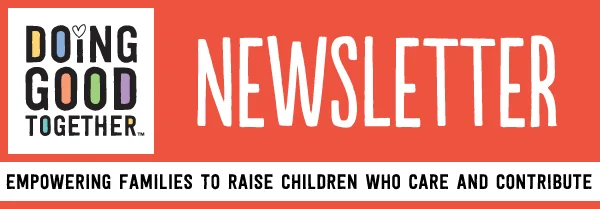ANIMAL LOVE
As you introduce your children to the big concepts of kindness and caring, you'll get further if you can link these ideas to everyday activities, or to projects that reflect your youngster's passions. For many children, that passion is animals. Spring is a great time to begin a family kindness practice that revolves around the care of our non-human friends. We provide a few simple ideas below.
-Jenny Friedman, Executive Director
KINDNESS IN ACTION
Make a Difference...
Create pet toys or bake dog biscuits. Share your handmade playthings and yummy treats with your own pets or with animals belonging to your friends or neighbors. Or donate them to your local animal rescue group.
Foster pets. Provide a temporary (a few days to a few months) home for animals that require special attention because they are very young, sick, or because the shelter has limited space. Call your local shelter to learn more about this rewarding activity.
Feed the birds. With spring comes birds! Be ready by creating your own backyard bird feeder. You can also donate your feeders to a local care facility, so the residents can hang them outside their windows and enjoy watching the birds. Check out these other great bird feeders to make with kids.
Advocate for animals. Choose an endangered animal from this state-by-state list. Learn about the creature together and have your child create an artwork about it, including its greatest threat. (Be sure to have your child sign it.) As your child works, talk about why it is important to protect this particular creature. Then help them draft a letter to your elected officialsdescribing the issues and asking them to help protect this new friend. Then hope for a response! Check out the Humane Society to find more kid-friendly animal advocacy issues your family can take on. For raptors, visit this Peregrine Fund site.
KICK-START COMPASSION FOR ANIMALS
Talk About It.....
Teaching children about kindness to animals can help develop empathy. It can encourage kids to think about another living being's feelings and to consider the effects of their actions. Here are ideas from Share the World, a program that educates children to better understand animals.
Talk about the importance of showing respect for all living creatures. Speak out when you see animal cruelty.
Share with your children some of the amazing characteristics that animals possess. For fun facts, visit the National Geographic Kids website.
Discuss the many wordless ways animals show their feelings — pain, hunger, excitement, loneliness. Ask your children how those emotions and responses are similar to their own.
Learn About It.....
The Dog Who Belonged to No One by Amy Hest , illustrated by Amy Bates (Abrams Books for Young Readers, 2008). Ages 3-7. A lonely little girl and a lonely pup find a best friend in each other.
Every Living Thing by Cynthia Rylant (Aladdin, 1988). Ages 10-14. A collection of 12 short stories about individuals whose lives were touched by their encounters with animals.
Humane Society of The United States: Just for Kids The youth education affiliate of The Humane Society of the United States, this website teaches young people about kindness and respect for animals, and includes a list of books and films, and a resource center.
INSPIRATION
"We need, in a special way, to work twice as hard to help people understand that the animals are fellow creatures, that we must protect them and love them as we love ourselves."
- César Chávez

